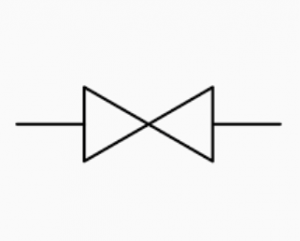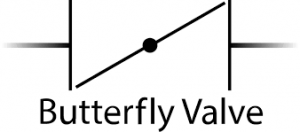Everything You Need to Know About Valve Symbols
Valves are the unsung hero of almost all industrial and engineering applications. You can find valves in use in pipelines, oil and gas, food and beverage, biopharma, marine, and many other industries.
No matter what the final industry is, each of them uses planning documents and diagrams to outline their system processes.
Without knowing the valve symbols, you’ll be at a loss for understanding the system.
Gate Valves
A gate valve will open or cut off the flow of water through a pipe. They typically have a wheel handle that gets turned to operate the metal disk that blocks the flow.
Its symbol looks like the outline of a bowtie with two straight lines crossing each other to form an “X”. Then two vertical lines connect the ends to create an enclosed shape.

Globe Valves
These valves are similar to the gate valve in how they regulate the flow of liquid. The main difference being the movable disk and stationary ring.
To differentiate these valves from gate valves, there’s a solid circle placed over the center of the “X” shape.

Ball Valves
A ball valve increases the control you have over the flow of liquid. Unlike the previous two that are straight on and off, a ball valve can direct the flow to align with a port.
The symbol is slightly different by making the solid center circle an outline instead.

Plug Valve
These valves control flow by using a linear motion to move a cylindrical or conically shaped plug inside of the body of the valve. To signify these valves, an outline of a diamond is used in the place of the circle.

Needle Valve
A needle valve is a perfect solution for when you need precise control of a low flow rate. A needle-shaped plunger moves up and down within the valve to open and close a small port.
To signify this precise valve on a diagram, the bowtie symbol is used with a downward pointing arrow in the center.

Diaphragm Valves
These valves have multiple ports within the body of the valve. The system then uses air pressure to control the opening and closing of the different valves.
Since these valves operate slightly differently from the previous valves we’ve discussed, it’s no surprise we see the first real variation in the symbol.
Take the bowtie symbol we have established and draw a horizontal line through the center of it. Now erase the top half. What you’re left with is the symbol for a diaphragm valve.

Butterfly Valves
These valves excel in tight locations. They have a spring-loaded handle that locks the valve into the open position.
The symbol for these valves consists of two vertical parallel lines. Then a diagonal line extends from the top of the left line to the bottom of the right line. In the center is a solid circle.

Know Your Valve Symbols
Knowing your valve symbols will make your life much easier when it comes time to decipher your pipe and system diagram. While each of these symbols has several variables for their different types of valves, these main category symbols will help get a general understanding.
Use our valve product selection guide to find the perfect part for your specific application.

